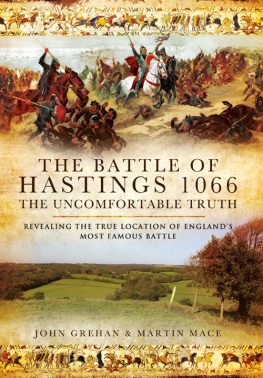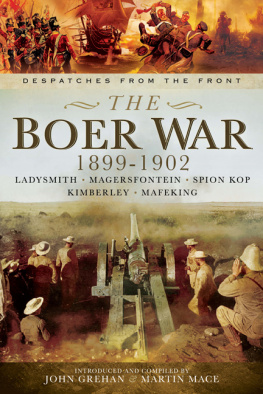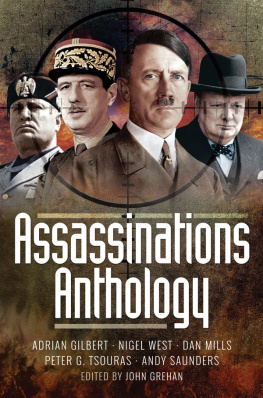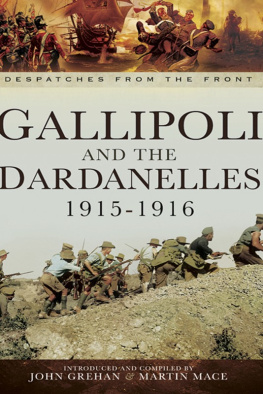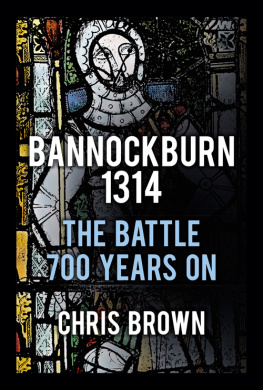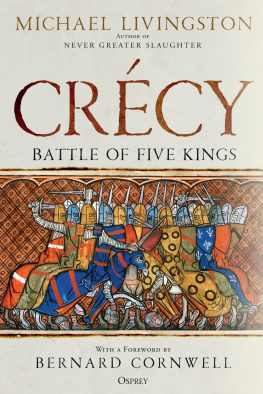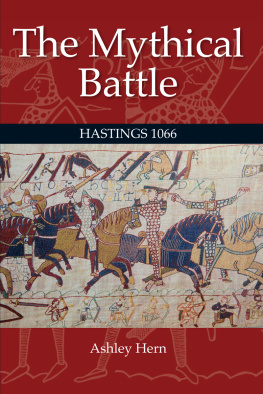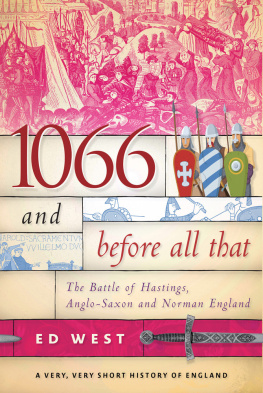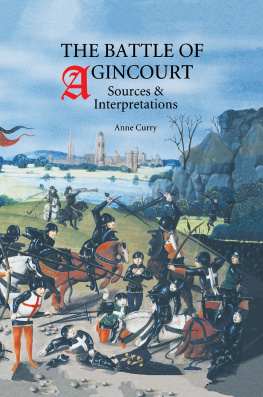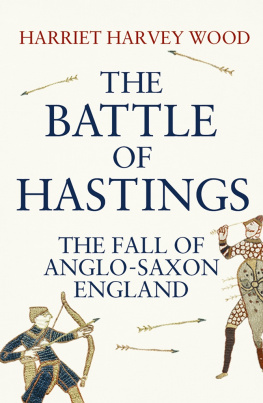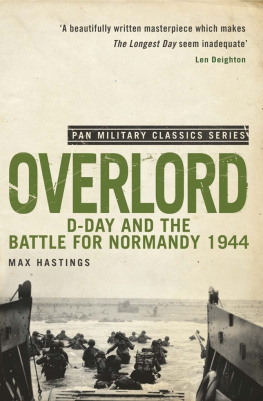It is puzzling given the enormous interest in Hastings that, despite the digging of foundations for the abbey, for the old primary school, for all the houses along the main road, all the digging in gardens, the road making, not a single trace of the battle has been found. Have people simply been looking in the wrong place?
Jim Bradbury, The Battle of Hastings

First published in Great Britain in 2012 by
Pen & Sword Military
an Imprint of
Pen & Sword Books Ltd
47 Church Street
Barnsley
South Yorkshire
S70 2AS
Copyright John Grehan and Martin Mace 2012
ISBN: 978 1 84884 827 6
ISBN: 9781781599846 (epub)
ISBN: 9781781599846 (prc)
The right of John Grehan and Martin Mace to be identified as authors of this work has been asserted by them in accordance with the Copyright, Designs and Patents Act 1988.
A CIP catalogue record for this book is available from the British Library.
All rights reserved. No part of this book may be reproduced or transmitted in any form or by any means, electronic or mechanical including photocopying, recording or by any information storage and retrieval system, without permission from the Publisher in writing.
Typeset in 11 pt Ehrhardt by
Mac Style, Beverley, E. Yorkshire
Printed and bound in the UK by CPI Group (UK) Ltd, Croydon, CRO 4YY
Pen & Sword Books Ltd incorporates the Imprints of Pen & Sword Aviation, Pen & Sword Family History, Pen & Sword Maritime, Pen & Sword Military, Pen & Sword Discovery, Wharncliffe Local History, Wharncliffe True Crime, Wharncliffe Transport, Pen & Sword Select, Pen & Sword Military Classics, Leo Cooper, The Praetorian Press, Remember When, Seaforth Publishing and Frontline Publishing.
For a complete list of Pen & Sword titles please contact
PEN & SWORD BOOKS LIMITED
47 Church Street, Barnsley, South Yorkshire, S70 2AS, England
E-mail:
Website: www.pen-and-sword.co.uk
Contents
Acknowledgements
I f we had not read Jim Bradbury's 1998 publication, The Battle of Hastings, we might have doubted our capacity to find documentary evidence to support our hypothesis, and this book would never have been written. He was, as far as we know, the first person in modern times to have suggested that the battle may not have been fought at the traditionally accepted site where the ruins of Battle Abbey now stand. That he welcomed our development of his idea is highly gratifying and it gave us the heart to see this venture through.
Yet, if Jim Bradbury was the inspiration, the team around us provided the perspiration. Stephen Hocking trudged every mile from Pevensey to Hastings and back, providing logistical support and an unending stream of healthy scepticism. Kelvin Nelson piloted the aircraft which enabled us to take the aerial photographs of the battlefield. Dave Cassan compiled the diagrams, adding much of his own interpretation. Dennis Mace's diligent proof reading was as meticulous as usual. Sarah Mitchell, with her knowledge of local medieval matters, cast her careful eye over the final manuscript.
Finally, we could never have found the time to complete our investigations had we not had the patient support of Leanne and Hannah.
John Grehan and Martin Mace
Storrington, 2012
Introduction
In the case of Hastings we know the basic facts The rest is a matter of possibility, probability and reasoned surmise.
Brigadier C.N. Barclay, Battle 1066
T he warriors stood defiantly on the front of the low hill, their untamed hair and drab clothing contrasting sharply with the glistening, polished steel of their swords and battleaxes. Below them at the foot of the rising ground were the mounted knights resplendent in chain mail and domed helmets.
With a single uttered command, the Normans urged their horses up the slope to engage the English. It was the start of the Battle of Hastings. The date was 14 October 2006.
It was a re-enactment of the most famous battle in English history and it was as realistic as the 2,000 or so participants could make it. Yet for all the banging of shields and defiant cries, and the thrust of lance and swing of sword, something was obviously wrong.
* * *
We had joined the many spectators for the annual re-playing of the Battle of Hastings which takes place every autumn in the grounds of Battle Abbey. We mingled with the crowds and meandered round the stalls selling chain mail for the purists and plastic swords for the kids.
We had read a good deal about the battle before we came. We knew that the English had stood upon a dominating ridge and that the Normans had struggled up the steep slope to hack and thrust at the defenders on the hill. What we saw on that pleasant October afternoon, however, was something quite different.
The English re-enactors had indeed placed themselves and their formidable shield wall as close to the top of the hill as the Abbey's buildings would permit. Against this position the heavily armoured Norman infantry and mounted knights flung themselves with authentic ardour. Yet this was not a difficult climb for the would-be Norman foot soldiers it was an easy walk up a very gentle slope. For the Norman knights the terrain was perfect for them to urge their steeds into a fully fledged gallop. This was not how it was supposed to be. The battle, we had been told, was fought on a steep and difficult hill which severely hampered the efforts of the attackers. Had we turned up at the wrong venue?
The day wore on and the clash of arms and the grunts of the happy participants continued repetitiously as must surely have happened almost nine and a half centuries ago. When we had seen enough of this bloodless battle we withdrew and decided to follow the route of the retreating English in 1066.
This took us over Caldbec Hill down to Oakwood Gill, the site of the famous English rearguard action at the Malfosse. As soon as we left the car park to walk across the lower slopes of Caldbec Hill we were immediately struck by the rugged terrain and the severity of the incline. We reached the top, not exactly breathless, but certainly conscious that we had climbed a not-inconsiderable hill.
From the summit we gazed southwards. Opposite we could see the heights of Telham Hill and then, below, a long way below, was Battle Abbey. It stood, from our lofty perspective, on a low, almost insignificant little ridge. Behind us, and to either side, the ground fell steeply away, just as steeply as in the front. We were standing on an excellent defensive position with commanding views all around. If Caldbec Hill was where Harold concentrated his army on the eve of the battle, as most believe, why would he abandon such a dominant spot to occupy an entirely inferior one?
It was a question for which we could find no answer. The more we looked, the more puzzled we became. We turned to each other and both voiced our thoughts. Has everyone got it wrong? Was the most significant battle in English history fought on Battle Hill, or somewhere else altogether?
Chapter 1
The Contradictory Evidence
Few subjects in English history have been studied more and for longer than the Norman Conquest, and few have been more bent in the process by biased interpretations based upon unhistorical prejudices.
R. Allen Brown, The Normans and the Norman Conquest
I n 1070 four Monks from the Benedictine abbey of Marmoutier on the Loire arrived at a place close to the Andresweald some eight miles or so to the north of Hastings. They were there on the orders of King William I of England. Following a visit to London by the representatives of Pope Alexander II, William agreed to pay a penance for the terrible slaughter he had caused when he invaded England. That penance was the building of a great monastery on the site of the battle where he had won the English crown. This part of Sussex was thinly populated and William wanted to ensure that no invader would be able to land as easily as he had and march upon London, so this monastery was granted special privileges to help it attract settlers to its extensive lands.
Next page
